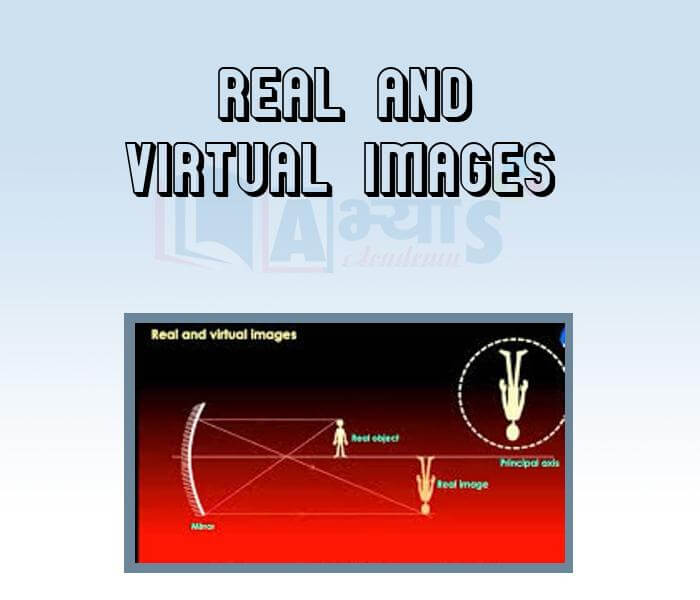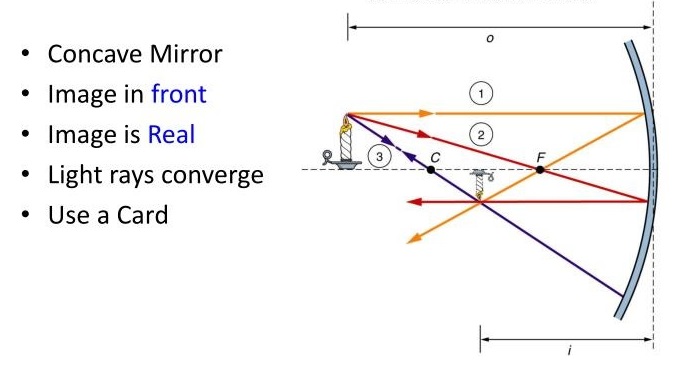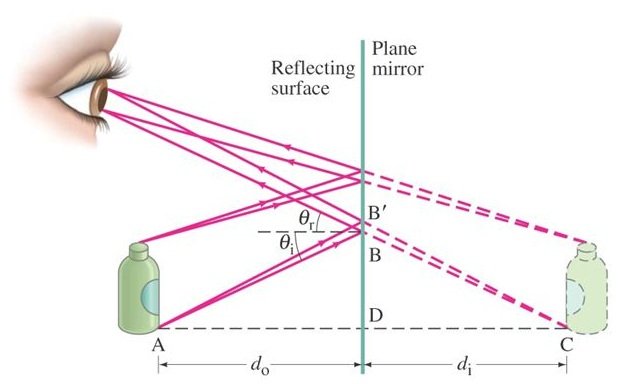Real and Virtual Images












Real and Virtual Images
When we look into a mirror, we see exactly a reflection of our face, hence known as image of our face. In this case, our face is the object and what we see in the mirror is its image. The image of our face appears to be situated behind the mirror. There are two types of images
Real Image:
The images that can be formed on the screen are called real images. They are formed by actual intersection of light rays. When the light coming from an object actually meet at a point after reflection form the mirror, then it results in the formation of a real image. A real image is formed when rays converge.

Virtual Image:
The images that cannot be taken on the screen are called virtual images. They are formed by the apparent intersection of light rays. When the light rays coming from an object appear to meet after reflection from the mirror, then it results in the formation of virtual image. It is not possible to form a virtual image on the screen because light rays actually do not pass the screen or cannot be received on a screen. a virtual image occurs where rays only appear to diverge.

Difference Between a Real and a Virtual Image:
S. No. |
Real image |
Virtual image |
| 1. | Real images can be formed on the screen | Virtual images can not be formed on the screen |
| 2. | Real images are formed by actual intersection of light rays | Virtual Images are formed by apparent intersection of light rays |
| 3. | Real images occurs where rays converge at a point. | Virtual Images occurs where rays only appear to diverge. |
| 4. | Real images are formed reflection from a concave mirror | Virtual images are formed after reflection from a convex mirror and plane mirror. |
| 5 | Real images are inverted | Virtual Images are erect. |
| 6. | Convex Lens form real images. | Concave lens forms virtual image. |
The images that can be formed on the screen are called _________________ images. | |||
| Right Option : A | |||
| View Explanation | |||
A virtual image is formed____________________ the mirror. | |||
| Right Option : A | |||
| View Explanation | |||
An image formed in front of the mirror is _______________ | |||
| Right Option : B | |||
| View Explanation | |||
Students / Parents Reviews [10]
It has a great methodology. Students here can get analysis to their test quickly.We can learn easily through PPTs and the testing methods are good. We know that where we have to practice

Barkha Arora
10thBeing a parent, I saw my daughter improvement in her studies by seeing a good result in all day to day compititive exam TMO, NSO, IEO etc and as well as studies. I have got a fruitful result from my daughter.

Prisha Gupta
8thMy experience with Abhyas academy is very good. I did not think that my every subject coming here will be so strong. The main thing is that the online tests had made me learn here more things.

Hiya Gupta
8thIt was a good experience with Abhyas Academy. I even faced problems in starting but slowly and steadily overcomed. Especially reasoning classes helped me a lot.

Cheshta
10thMy experience was very good with Abhyas academy. I am studying here from 6th class and I am satisfied by its results in my life. I improved a lot here ahead of school syllabus.

Ayan Ghosh
8thAbout Abhyas metholodology the teachers are very nice and hardworking toward students.The Centre Head Mrs Anu Sethi is also a brilliant teacher.Abhyas has taught me how to overcome problems and has always taken my doubts and suppoeted me.

Shreya Shrivastava
8thMy experience with Abhyas is very good. I have learnt many things here like vedic maths and reasoning also. Teachers here first take our doubts and then there are assignments to verify our weak points.

Shivam Rana
7thAbhyas is a complete education Institute. Here extreme care is taken by teacher with the help of regular exam. Extra classes also conducted by the institute, if the student is weak.

Om Umang
10thAbhyas Methodology is very good. It is based on according to student and each child manages accordingly to its properly. Methodology has improved the abilities of students to shine them in future.

Manish Kumar
10thOne of the best institutes to develope a child interest in studies.Provides SST and English knowledge also unlike other institutes. Teachers are co operative and friendly online tests andPPT develope practical knowledge also.
